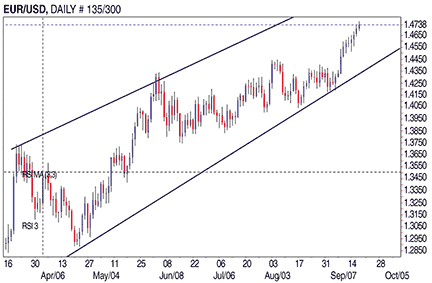FOREX FOCUS
In Uncertain Economic Times
Cross-Currency Coefficients
How do currency pairs move in correlation to their US dollar counterparts?
When we think about correlation coefficients between two currency pairs, we usually think about correlations among the major pairs against the US dollar such as the euro/US dollar (Eur/Usd), British pound/US dollar (Gbp/Usd), or their direct opposites, US dollar/Swiss franc (Usd/Chf) and US dollar/Japanese yen (Usd/Jpy). One topic not mentioned in the research was the correlation among currency crosses that directly correspond to their US dollar counterparts. How these pairs move in relation to their Usd counterparts will be the subject of this article as well as the Pearson product moment coefficient to determine how to factor various correlation coefficients.
Correlation of currency pairs
When we measure correlation, we are measuring strength and direction of a linear relationship between two random variables, in this instance two currency pairs. Pearson’s product moment coefficient is the most popular factor because it measures an absolute value from -1 to +1 of a pair by dividing the covariance of two variables by the product of its standard deviation. Absolute value in this case refers to the measurement of distance as measured on a number line, and hence negative and positive values. In one instance, we are measuring X and Y slopes in terms of the absolute values. Knowing absolute values of a currency pair will almost answer the question of how far a pair will move in relation to its counterpart based on an X,Y slope.
To specifically determine an exact location of the X and Y plot where prices are located at any time, use the correlation of determination. An absolute value of +1 says a pair has a direct correlation, and an absolute value of -1 implies a negative correlation. But currency correlations rarely reflect a perfect relationship. A correlation coefficient that is in the high 80s or low 90s can be considered to be near perfect when the relationship is positive and a coefficient in the 20s to 30s can be considered to be negatively correlated.

Figure 1: eur/usd, daily. Note the uptrend in the EUR/USD since April 12, 2009. Compare this chart to Figure 2.
For example, based on September correlations, we know that Eur/Usd and the Australian dollar/US dollar (Aud/Usd) have a monthly absolute value of 0.74, a three-month absolute value of 0.76, and a six-month absolute value of 0.72. This positive relationship means in terms of Usd that the Eur and Aud will move together 74%, 76%, and 72% of the time for the next six months.